Relationship between Toothpaste Dilution Ratio and Droplets Generated during Tooth-Brushing
Abstract
:1. Introduction
2. Materials and Methods
2.1. Study Design and Development of a Droplet Evaluation Model Using a Single-Axis Robot
2.2. Preparation of a Model Toothpaste
2.3. Viscosity of Toothpaste
2.4. High-Speed Camera Observation at the Time of Droplet Generation
2.5. Statistical Analysis
3. Results
3.1. Viscosity of Toothpaste According to Dilution Ratio
3.2. Amount and Properties of Droplets for Each Toothpaste Dilution Ratio
3.3. Maximum Droplet Flight Distance for Each Toothpaste Dilution Ratio
3.4. Changes in the Number of Droplets and Flight Distance for Each Toothpaste Dilution Ratio
3.5. High-Speed Camera Observation at the Moment of Droplets Generation
4. Discussion
5. Conclusions
Author Contributions
Funding
Institutional Review Board Statement
Informed Consent Statement
Data Availability Statement
Acknowledgments
Conflicts of Interest
References
- Lash, R.R.; Moonan, P.K.; Byers, B.L.; Bonacci, R.A.; Bonner, K.E.; Donahue, M.; Donovan, C.V.; Grome, H.N.; Janssen, J.M.; Magleby, R.; et al. COVID-19 Contact Tracing Assessment Team. COVID-19 case investigation and contact tracing in the US, 2020. JAMA Netw. Open 2021, 4, e2115850. [Google Scholar] [CrossRef] [PubMed]
- Liu, Z.; Bing, X.; Za, Q.; Zhonghua, Z.; Zazhi, L. The epidemiological characteristics of an outbreak of 2019 novel coronavirus diseases (COVID-19) in China, Epidemiology Working Group for NCIP Epidemic Response. Chinese Center for Disease Control and Prevention. Zhonghua Liu Xing Bing Xue Za Zhi 2020, 41, 145–151. [Google Scholar] [CrossRef]
- Therapeutics and COVID-19: Living Guideline, (n.d.). Available online: https://www.who.int/publications-detail-redirect/WHO-2019-nCoV-therapeutics-2021.3 (accessed on 13 November 2021).
- Mateos-Moreno, M.V.; Mira, A.; Ausina-Márquez, V.; Ferrer, M.D. Oral antiseptics against coronavirus: In-vitro and clinical evidenc. J. Hosp. Infect. 2021, 113, 30–43. [Google Scholar] [CrossRef] [PubMed]
- Komine, A.; Yamaguchi, E.; Okamoto, N.; Yamamoto, K. Virucidal activity of oral care products against SARS-CoV-2 in vitro. J. Oral Maxillofac. Surg. Med. Pathol. 2021, 233, 475–477. [Google Scholar] [CrossRef] [PubMed]
- Isho, B.; Abe, K.T.; Zuo, M.; Jamal, A.J.; Rathod, B.; Wang, J.H.; Li, Z.; Chao, G.; Rojas, O.L.; Bang, Y.M.; et al. Persistence of serum and saliva antibody responses to SARS-CoV-2 spike antigens in COVID-19 patients. Sci. Immunol. 2020, 5, eabe5511. [Google Scholar] [CrossRef] [PubMed]
- Levine-Tiefenbrun, M.; Yelin, I.; Katz, R.; Herzel, E.; Golan, Z.; Schreiber, L.; Wolf, T.; Nadler, V.; Ben-Tov, A.; Kuint, J.; et al. Initial report of decreased SARS-CoV-2 viral load after inoculation with the BNT162b2 vaccine. Nat. Med. 2021, 27, 790–792. [Google Scholar] [CrossRef] [PubMed]
- Sakaguchi, W.; Kubota, N.; Shimizu, T.; Saruta, J.; Fuchida, S.; Kawata, A.; Yamamoto, Y.; Sugimoto, M.; Yakeishi, M.; Tsukinoki, K. Existence of SARS-CoV-2 entry molecules in the oral cavity. Int. J. Mol. Sci. 2020, 21, 6000. [Google Scholar] [CrossRef] [PubMed]
- Japan Association of School Dentists HP. Available online: https://www.nichigakushi.or.jp/ (accessed on 12 December 2021).
- Japan Dental Association HP. Available online: https://www.jda.or.jp/ (accessed on 12 December 2021).
- Japanese Society of Pediatric Dentistry HP. Available online: https://www.jspd.or.jp/ (accessed on 12 December 2021).
- Satou, R.; Suzuki, S.; Takayanagi, A.; Yamagishi, A.; Sugihara, N. Modified toothpaste application using prepared toothpaste delivering technique increases interproximal fluoride toothpaste delivery. Clin. Exp. Dent. Res. 2020, 6, 188–196. [Google Scholar] [CrossRef] [Green Version]
- Mark, E.P.; Lewis, M.; Graziani, F.; Atlas, B.; Utsch, J. Droplet sizes emitted from demonstration electric toothbrushes. Int. J. Environ. Res. Public Health 2021, 18, 2320. [Google Scholar] [CrossRef] [PubMed]
- Stovell, A.G.; Newton, B.M.; Lynch, R.J. Important considerations in the development of toothpaste formulations for children. Int. Dent. J. 2013, 63 (Suppl. 2), 57–63. [Google Scholar] [CrossRef]
- Koga, H.; Yamagishi, A.; Takayanagi, A.; Maeda, K.; Matsukubo, T. Estimation of optimal amount of fluoride toothpaste for adults to prevent caries by comparison between fluoride uptake into enamel in vitro and fluoride concentration in oral fluid in vivo. Bull. Tokyo Dent. Coll. 2007, 48, 119–128. [Google Scholar] [CrossRef]
- Meister, T.L.; Brüggemann, Y.; Todt, D.; Conzelmann, C.; Müller, J.A.; Groß, R.; Münch, J.; Krawczyk, A.; Steinmann, J.; Steinmann, J.; et al. Virucidal efficacy of different oral rinses against severe acute respiratory syndrome coronavirus 2. J. Infect. Dis. 2020, 222, 1289–1292. [Google Scholar] [CrossRef] [PubMed]
- JDH—February 2021|ADHA—American Dental Hygienists Association, (n.d.). Available online: https://www.adha.org/jdh-feb2021 (accessed on 30 November 2021).
- Tateyama-Makino, R.; Abe-Yutori, M.; Iwamoto, T.; Tsutsumi, K.; Tsuji, M.; Morishita, S.; Kurita, K.; Yamamoto, Y.; Nishinaga, E.; Tsukinoki, K. The inhibitory effects of toothpaste and mouthwash ingredients on the interaction between the SARS-CoV-2 spike protein and ACE2, and the protease activity of TMPRSS2 in vitro. PLoS ONE 2021, 16, e0257705. [Google Scholar] [CrossRef] [PubMed]
- Walsh, T.; Worthington, H.V.; Glenny, A.M.; Marinho, V.C.; Jeroncic, A. Fluoride toothpastes of different concentrations for preventing dental caries. Cochrane Database Syst. Rev. 2019, 3, CD007868. [Google Scholar] [CrossRef] [PubMed]
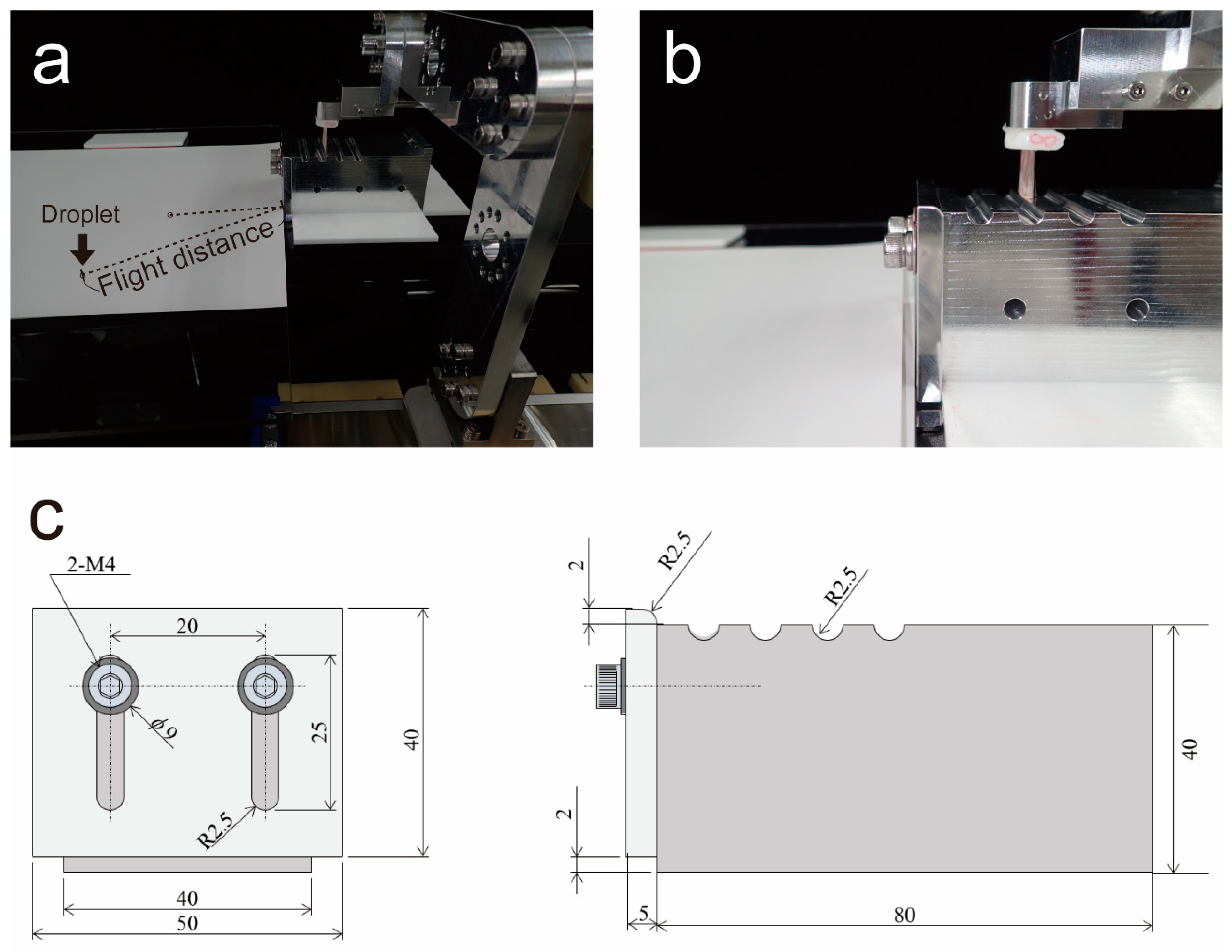
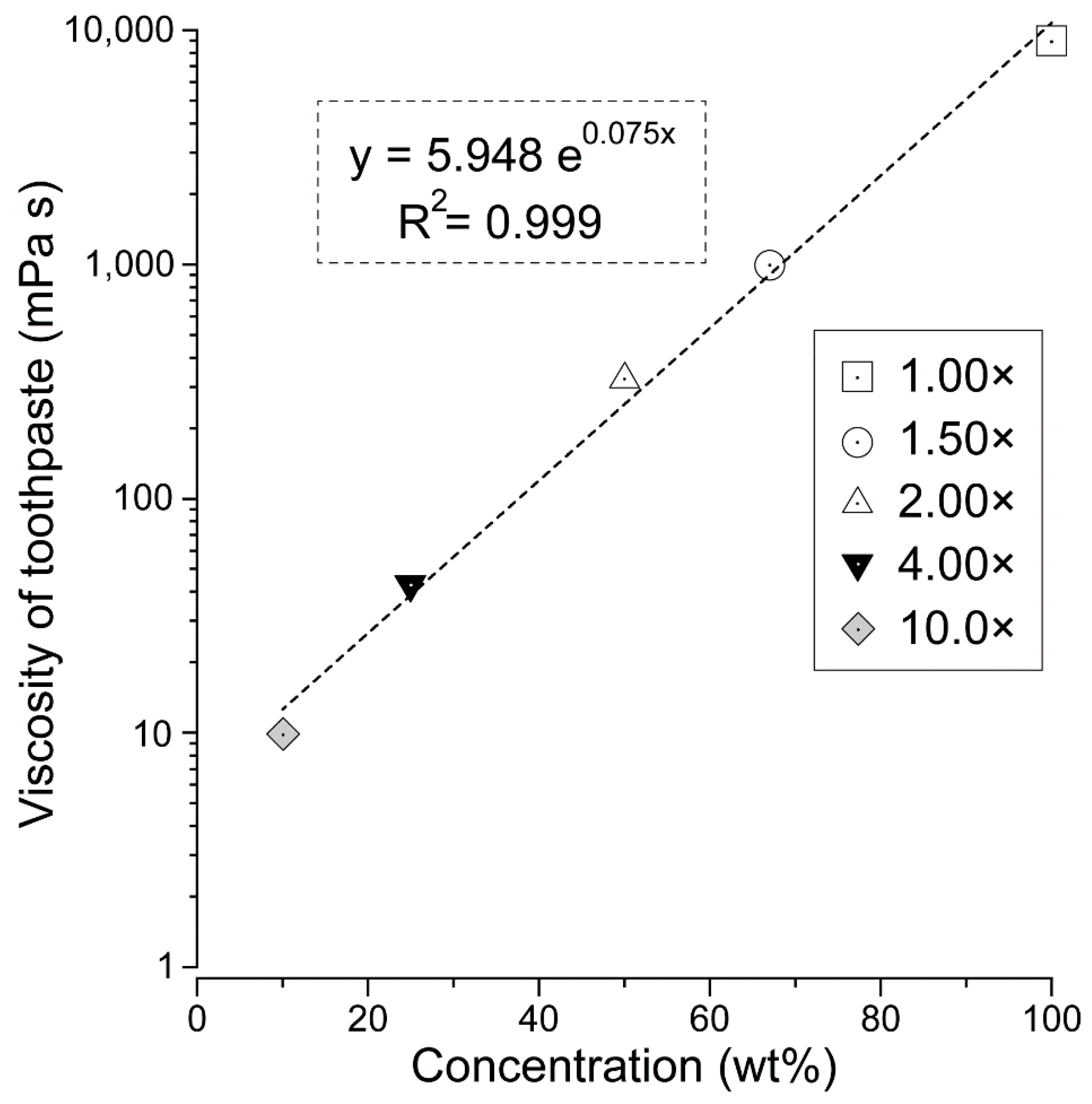
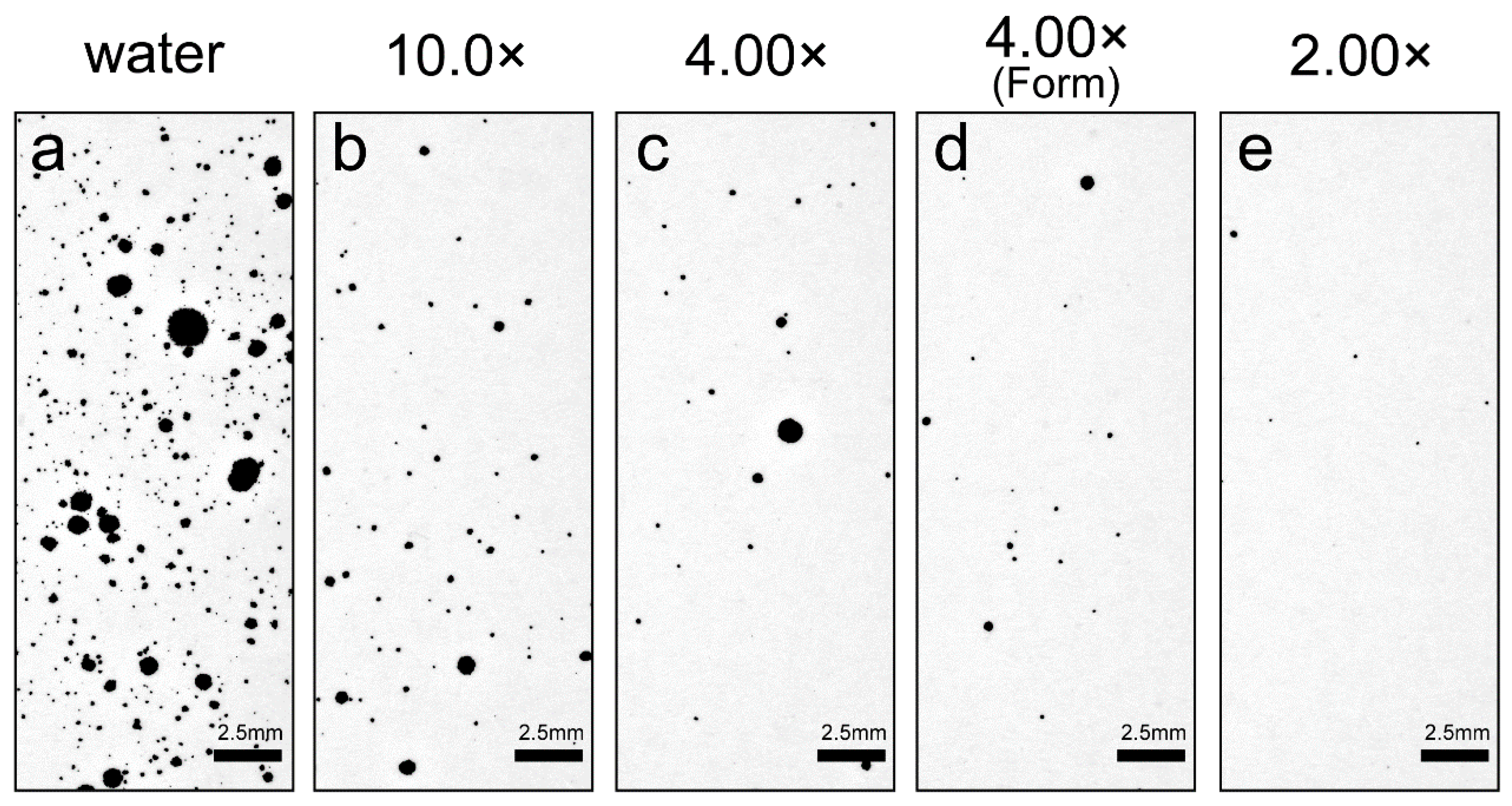
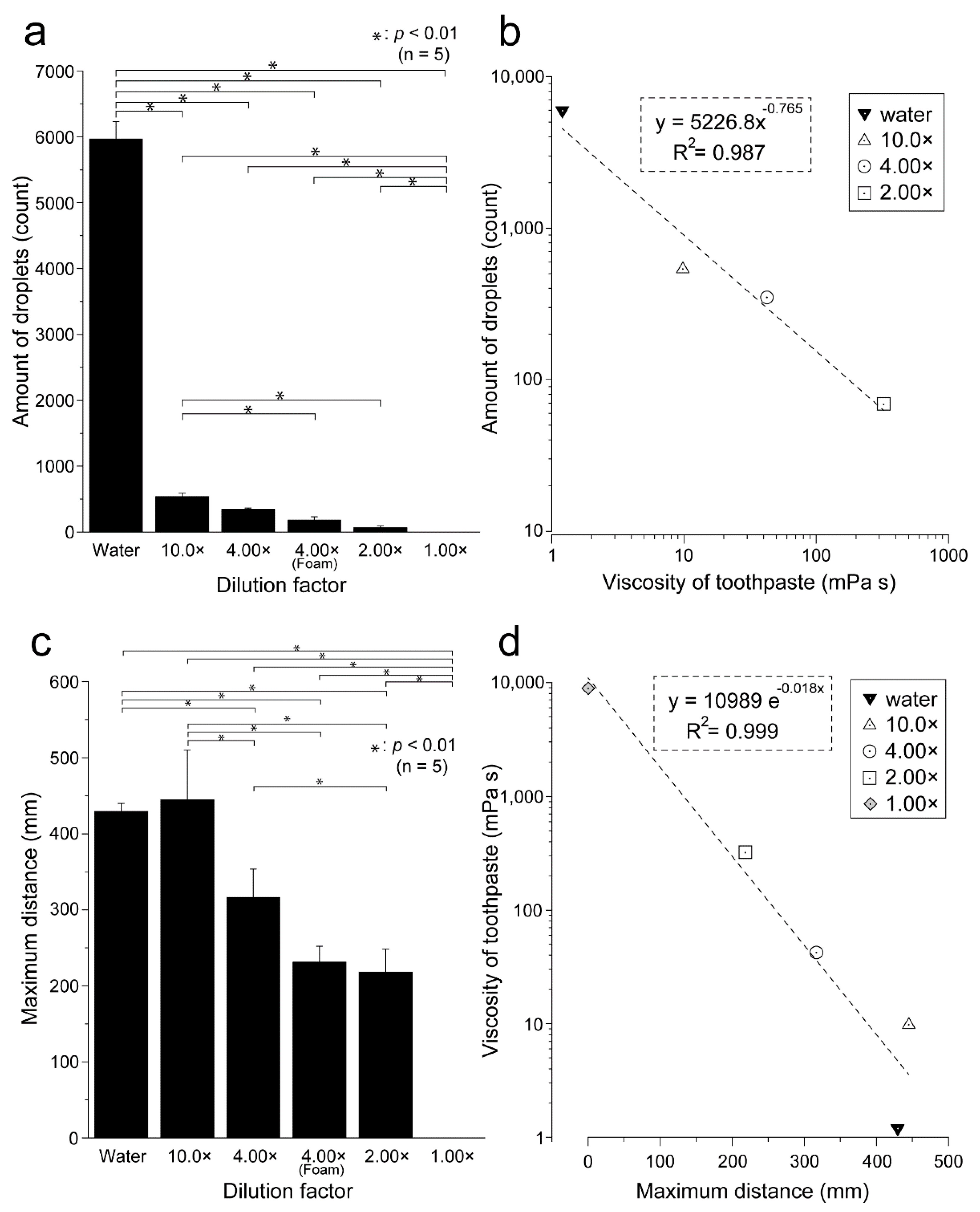
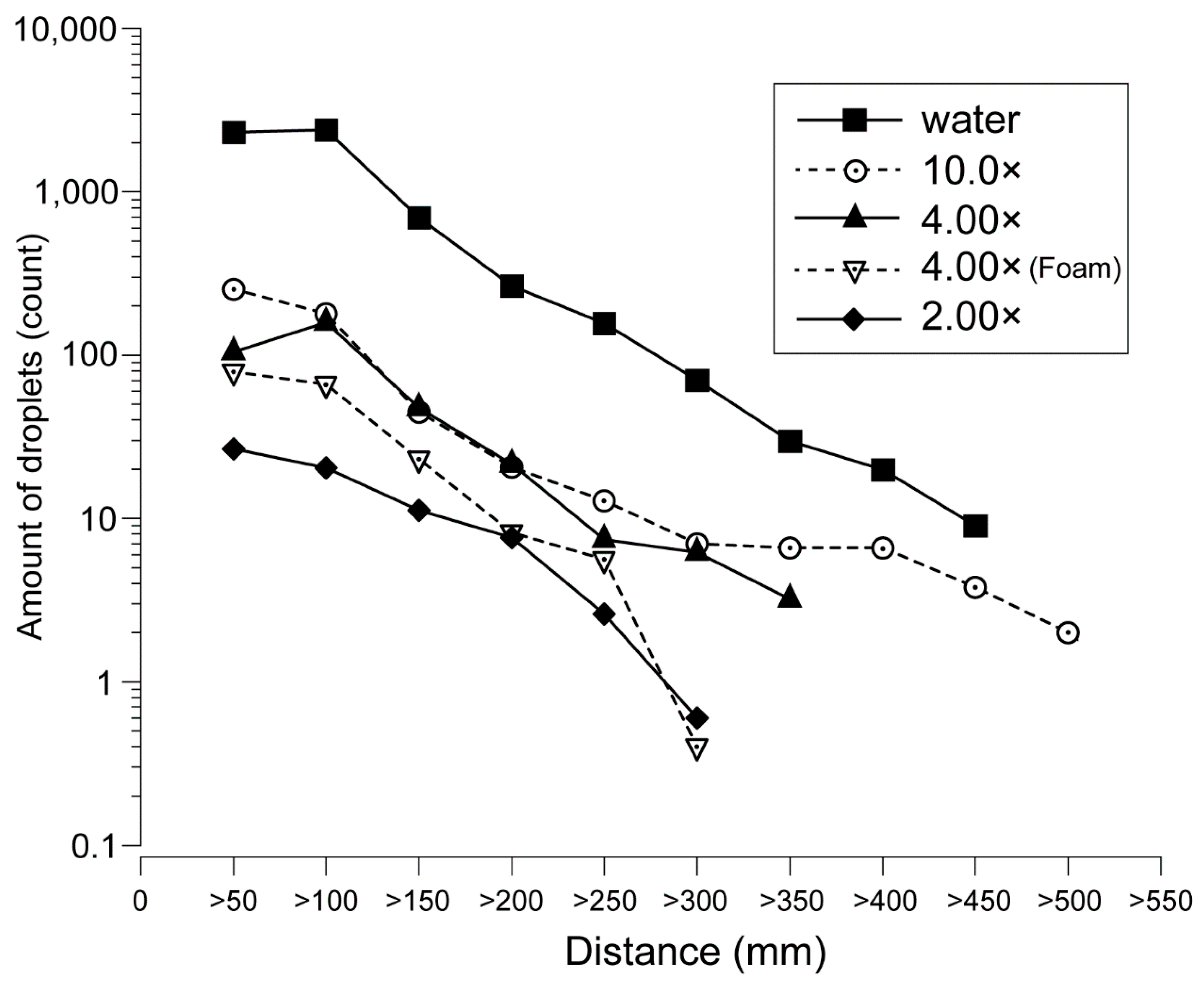

| Concentration (wt%) | Viscosity (mPa × s) | Droplets Count | Maximum Distance (mm) | |
|---|---|---|---|---|
| Water | 0 | 1.2 | 5965 ± 266 | 429 ± 11 |
| 10.0× | 10 | 9.8 | 538 ± 56 | 445 ± 65 |
| 4.00× | 25 | 42.5 | 349 ± 15 | 316 ± 38 |
| 4.00× (Form) | - | - | 183 ± 49 | 231 ± 21 |
| 2.00× | 50 | 324 | 69 ± 27 | 218 ± 30 |
| 1.00× | 100 | 8930 | 0 | 0 |
Publisher’s Note: MDPI stays neutral with regard to jurisdictional claims in published maps and institutional affiliations. |
© 2022 by the authors. Licensee MDPI, Basel, Switzerland. This article is an open access article distributed under the terms and conditions of the Creative Commons Attribution (CC BY) license (https://creativecommons.org/licenses/by/4.0/).
Share and Cite
Satou, R.; Yamagishi, A.; Takayanagi, A.; Higuchi, T.; Oyama, T.; Suzuki, S.; Sugihara, N. Relationship between Toothpaste Dilution Ratio and Droplets Generated during Tooth-Brushing. Int. J. Environ. Res. Public Health 2022, 19, 4157. https://doi.org/10.3390/ijerph19074157
Satou R, Yamagishi A, Takayanagi A, Higuchi T, Oyama T, Suzuki S, Sugihara N. Relationship between Toothpaste Dilution Ratio and Droplets Generated during Tooth-Brushing. International Journal of Environmental Research and Public Health. 2022; 19(7):4157. https://doi.org/10.3390/ijerph19074157
Chicago/Turabian StyleSatou, Ryouichi, Atsushi Yamagishi, Atsushi Takayanagi, Takuro Higuchi, Tsutomu Oyama, Seitaro Suzuki, and Naoki Sugihara. 2022. "Relationship between Toothpaste Dilution Ratio and Droplets Generated during Tooth-Brushing" International Journal of Environmental Research and Public Health 19, no. 7: 4157. https://doi.org/10.3390/ijerph19074157







